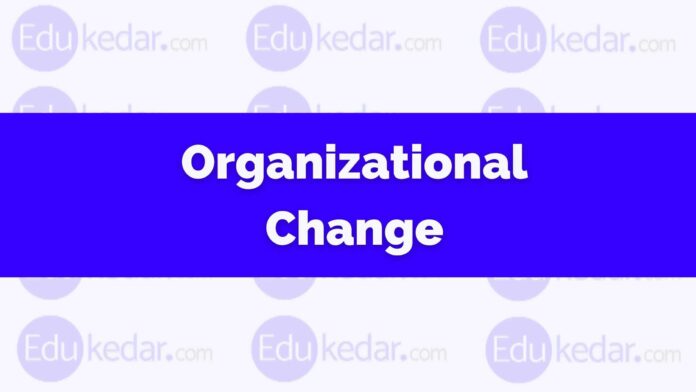Organizational Change Management is the organized, systematic application of knowledge, tools, and resources of change that provide organizations with a key process to achieve their business strategy.
Change is considered an inevitable process. Change is a response to any dynamic external and internal force that change current realities.
When change occurs in any part of the organization it disturbs the old equilibrium and a modification or transformation is required to establish a new equilibrium. The type of new equilibrium depends on the extent of change and its effect on the organization.
In this article, you get a complete overview of the following things
- What is organizational change, and what meaning and various definitions are given by different authors
- Nature of organizational change,
- Importance of organizational change,
- Factors that led to organizational change, and at last
- The process of organizational
► What is Organisational Change?
Organizational change is defined as the process of alteration of organizational structure and the implementation of new procedures and organizational structure which help an organization to adapt to the changing nature of its business environment and grab new business opportunities.
◉ Meaning of Organisational Change
Organization change is a term formed by the combination of two words Organisation and change. Change word means refers to any alteration and Organization word means when a group of people work together in an organized way for a shared objective or goal.
In simple words, an organizational change is defined as the change in attitude, behavior, and interest of employees, rules regulations, policies, and technological and environmental changes of an organization so that organization aligns with the forces affecting the organization.
◉ Definition of Organisational Change
► Nature of Organizational Change
► Importance of Organizational Change
- It encourages innovation and technological growth.
- If any changes occur in the organization then to cope with change employees learn new skills.
- It provides new growth opportunities to employees.
- It reduces future risk and uncertainty.
- Changes make organizations more effective and efficient.
- Continuous and valuable changes in organizational elements provide a competitive advantage.
► Types of Organizational Change
There are five types of organizational change-
- Organizational wide change
- Transformational change
- Unplanned change
- Remedial change
- Personnel change
✔ 1. Organization-Wide Change
Organization-wide change is considered a is a large-scale change or transformation that affects the overall structure of the company. In this change, the resizing of the organization, and restructuring of the organization is done.
✔ 2. Transformational Change
Transformational change is very important for organizations because organizations are constantly under the threat from many factors. A company must know all the changing business environment factors around them like cultural trends, understanding the social climate, and technological advances.
Transformational change deals with the formulation and implementation of new strategies so that organizations can successfully address the rapid changes that take place in a business environment.
✔ 3. Personnel Change
Personnel change implies that the company undergoes mass hiring or layoffs or changes in the organization’s human resource structure. These types of changes take place when organization there is any change in technology or the organization incurs losses. This type of change brings fresh talent to the organization and lay off the less productive employees.
These types of changes bring a crucial effect on the employee engagement and retention strategy of the organization and give new kinds of exposure to businesses to catch emerging opportunities.
✔ 4. Unplanned Change
Generally, an organization can undergo a number of unplanned changes. they occur randomly and spontaneously without having the time to react. These types of changes are introduced by an organization in response to a change in the demographic composition or performance gap of an organization.
Many times sudden changes in government regulation and global economic conditions also force companies to go for a sudden and unplanned change.
✔ 5. Remedial Change
The remedial changes are brought about when corrective action is required. The organization generally used remedial change when performance levels of the organization dropped or when suffering from financial crises.
These remedial changes are the reactionary or corrective actions taken by the organization’s management. The main objective of the remedial change is to respond to the issue that creates hurdles in organizational functioning.
Also Read : What is Organizational Behaviour?
► Factors Cause Organizational Change
- Internal Factors
- External Factors
1. Internal Factors in Organizational Change
- Changes in managerial personnel
- Work condition
- Delegation of power and authority
- Employee motivation
- Workplace culture and environment
- Policies and procedures established by the organization
- Employee expectation
2. External Factors
- Globalization
- Technological change
- Economical change
- Social and political change
- Workforce diversity
- Demographic dividend
Process of Organisational Change
The process of organizational change has the following steps-
- Identifying the need for change
- Determining the organization elements to be changed
- Planning for effective change
- Assessing the change force
- Actions for change i.e Unfreezing, Changing and Refreezing
Kurt Lewin’s Process of Organization Change
Kurt Lewin has a three-phase process:-
✔ 1. Unfreezing
It is the first phase of the process of unfreezing an individual should unlearn all the old things so that it becomes easy to learn new things.
✔ 2. Changing
In the second phase of the process, the organization implements the change.
✔ 3. Refreezing
This is the last phase of Kurt Lewin’s organizational change process in this phase organization tries to stabilize the implemented change.





